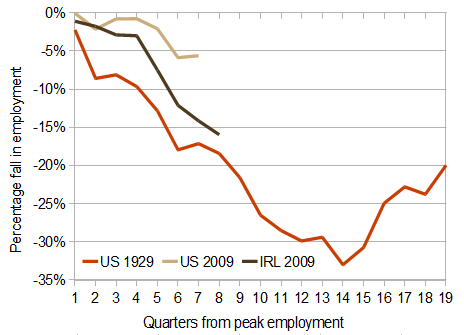Last week, I looked at the latest US private sector employment figures. Updating a graph from earlier in the year comparing all post-war recessions confirmed the current downturn as easily the worst recession by that metric. A comparison of the current recession with the Great Depression reveals the very different scales between a recession and a depression.
So, when is a recession a depression? A oft-quoted rule of thumb is that a depression only really kicks in when you’ve a fall in GDP of 10% or more. The jobs equivalent, going by last week’s graph, would suggest a depression kicks in when you lost certainly more than 10% of your jobs; until that you’re only in recession territory and it looks very likely – even when only focusing on private sector employment – that the US is going to avoid a jobs depression this time around.
But what about Ireland? Some people’s tweets about last week’s post got lost in translation and people thought that references to the number of jobs needed to recover were about Ireland… so why not work out the figures for Ireland? First things first, I’m reluctant to compare Ireland and the US, because I strongly believe that the global recession is just a coincidence for Ireland, whose exports have held up remarkably well, while other (less open) countries saw their exports tumble.
That said, it’s possible to compare job losses in Ireland now with those in the US, both now and in the Great Depression. For the US, I’ve used the same statistics as last week, including the NBER employment series for the 1930s, I’ve just turned them into quarterly figures. For Ireland, I’ve used CSO data on private sector employment from the Quarterly Household survey. These figures only run to Q2 so I’ve taken advantage of the high degree of correlation between Live Register increases and QNHS job losses to estimate a number for Q3 2009. The resulting graph is below.

The graph is striking. If the latest Live Register figures translate into QNHS results when they come out, about 270,000 private sector jobs have been lost in Ireland – that’s about 16% of all private sector jobs. At the same point in the Great Depression, the US had lost 18% of jobs, compared to losses of just 6% this time around. It’s very clear from these figures that Ireland is suffering a severe jobs depression – not just a recession. And again, this is not being caused by global factors – it’s domestic demand and investment that have collapsed, not foreign demand for Irish-made goods.
One glimmer of hope is that the Live Register, measuring the numbers in receipt of jobseekers benefits and allowances, actually fell in September. If this trend continues and the Live Register does level off about 450,000 rather than 500,000, then perhaps Ireland will only lose one in six of its private sector jobs, rather than the one in three the US experienced in the 1930s.
So, how long will it take Ireland to get back to 1.7m private sector jobs? Well, the first thing to know is where you’re recovering from. Suppose that a floor is indeed reached at about 300,000 job losses, i.e. soon. In the heady days of the Celtic Tiger, Ireland added an average of 6,000 jobs a month, every month, in the decade to 2007. The bulk of this was provided by construction and public services and related sectors. Assuming that our future growth is less dominated by construction and public services, it seems reasonable that the most we can hope to see is 3,000 net new jobs a month on average. In that case, it will be in 2018, after almost 100 months of jobs growth, until we see 2007 employment levels again – and that’s only if jobs growth returns within the next 12 months.
Given the severity of the jobs crisis, it is important that once we get in to the new year, the limelight, which been so hogged by NAMA and the Government’s finances, can move back to our jobs crisis. The €11bn in lost earnings from the 300,000 job losses is an annual cost to society that’s easily comparable to our worst nightmares about public finances or the banking system. And that’s not even factoring in the human costs of unemployment.
Ireland is Officially In Depression - Page 3 - Politics.ie ,
[…] real. This is worth a read for a good comparison of Ireland now versus USA now/USA in the 1930s: Is Ireland in a jobs recession or a jobs depression? | Ronan Lyons It includes an instructive graph of private sector job […]
Long-term unemployment must rise to top of the agenda in 2010 | Ronan Lyons ,
[…] October, I painted a rather bleak picture of Ireland’s unemployment situation, with the percentage of private sector jobs lost in the economy much closer to the 1930s USA than its contemporary US counterpart. At the end, I wrote: Given the severity of the jobs crisis, […]